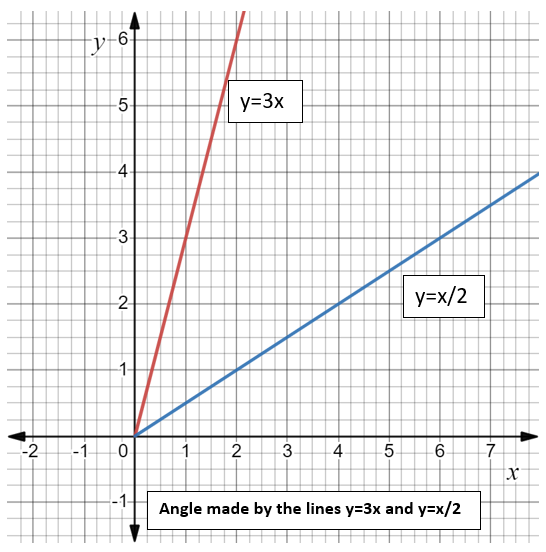
If \[\left( {a,{a^2}} \right)\] falls inside the angle made by the lines \[y = \dfrac{x}{2}, x > 0\] and \[y = 3x, x > 0\]. Then find the interval of \[a\].
A. \[\left( {3,\infty } \right)\]
B. \[\left( {\dfrac{1}{2},3} \right)\]
C. \[\left( { - 3, - \left( {\dfrac{1}{2}} \right)} \right)\]
D. \[\left( {0,\dfrac{1}{2}} \right)\]
Answer
218.7k+ views
Hint In the given question, two equations of lines and a point are given. We substitute the coordinates of the point in both equations and apply the conditions of greater than 0 or less than 0. In the end, simplify both inequality equations and get the interval of \[a\].
Formula used
If a point \[\left( {{x_1},{y_1}} \right)\] lies above the line \[ax + by = c\], then the inequality equation is \[a{x_1} + b{y_1} > c\].
If a point \[\left( {{x_1},{y_1}} \right)\] lies below the line \[ax + by = c\], then the inequality equation is \[a{x_1} + b{y_1} < c\].
Complete step by step solution:
The given equations of lines are \[y = \dfrac{x}{2}, x > 0\] and \[y = 3x, x > 0\].
The point \[\left( {a,{a^2}} \right)\] lies inside the angle made by the given two lines.

The point \[\left( {a,{a^2}} \right)\] lies above the line \[y - \dfrac{x}{2} = 0, x > 0\].
So, the inequality equation is
\[{a^2} - \dfrac{a}{2} > 0\]
\[ \Rightarrow \]\[a\left( {a - \dfrac{1}{2}} \right) > 0\]
\[ \Rightarrow \]\[a > 0\] and \[a > \dfrac{1}{2}\] \[.....\left( 1 \right)\]
The point \[\left( {a,{a^2}} \right)\] lies below the line \[y - 3x = 0, x > 0\].
So, the inequality equation is
\[{a^2} - 3a < 0\]
\[ \Rightarrow \]\[a\left( {a - 3} \right) < 0\]
\[ \Rightarrow \]\[a < 0\] and \[a < 3\] \[.....\left( 2 \right)\]
From equation \[\left( 1 \right)\] and \[\left( 2 \right)\], we get
\[a > \dfrac{1}{2}\] or \[a < 0\] and \[0 < a < 3\]
\[ \Rightarrow \]\[\dfrac{1}{2} < a < 3\]
\[ \Rightarrow \]\[a \in \left( {\dfrac{1}{2},3} \right)\]
Hence the correct option is B.
Note:The “and” word represents the intersection of two sets and the “or” word denotes the union of two sets. Students are often confused by these two words.
Students often get confused in the conversion of the inequality into an interval. Use the following rules to understand the conversion.
\[a < x < b \Rightarrow x \in \left( {a,b} \right)\]
\[a < x \le b \Rightarrow x \in \left( {a,b} \right]\]
\[a \le x < b \Rightarrow x \in \left[ {a,b} \right)\]
\[a \le x \le b \Rightarrow x \in \left[ {a,b} \right]\]
Formula used
If a point \[\left( {{x_1},{y_1}} \right)\] lies above the line \[ax + by = c\], then the inequality equation is \[a{x_1} + b{y_1} > c\].
If a point \[\left( {{x_1},{y_1}} \right)\] lies below the line \[ax + by = c\], then the inequality equation is \[a{x_1} + b{y_1} < c\].
Complete step by step solution:
The given equations of lines are \[y = \dfrac{x}{2}, x > 0\] and \[y = 3x, x > 0\].
The point \[\left( {a,{a^2}} \right)\] lies inside the angle made by the given two lines.

The point \[\left( {a,{a^2}} \right)\] lies above the line \[y - \dfrac{x}{2} = 0, x > 0\].
So, the inequality equation is
\[{a^2} - \dfrac{a}{2} > 0\]
\[ \Rightarrow \]\[a\left( {a - \dfrac{1}{2}} \right) > 0\]
\[ \Rightarrow \]\[a > 0\] and \[a > \dfrac{1}{2}\] \[.....\left( 1 \right)\]
The point \[\left( {a,{a^2}} \right)\] lies below the line \[y - 3x = 0, x > 0\].
So, the inequality equation is
\[{a^2} - 3a < 0\]
\[ \Rightarrow \]\[a\left( {a - 3} \right) < 0\]
\[ \Rightarrow \]\[a < 0\] and \[a < 3\] \[.....\left( 2 \right)\]
From equation \[\left( 1 \right)\] and \[\left( 2 \right)\], we get
\[a > \dfrac{1}{2}\] or \[a < 0\] and \[0 < a < 3\]
\[ \Rightarrow \]\[\dfrac{1}{2} < a < 3\]
\[ \Rightarrow \]\[a \in \left( {\dfrac{1}{2},3} \right)\]
Hence the correct option is B.
Note:The “and” word represents the intersection of two sets and the “or” word denotes the union of two sets. Students are often confused by these two words.
Students often get confused in the conversion of the inequality into an interval. Use the following rules to understand the conversion.
\[a < x < b \Rightarrow x \in \left( {a,b} \right)\]
\[a < x \le b \Rightarrow x \in \left( {a,b} \right]\]
\[a \le x < b \Rightarrow x \in \left[ {a,b} \right)\]
\[a \le x \le b \Rightarrow x \in \left[ {a,b} \right]\]
Recently Updated Pages
The maximum number of equivalence relations on the-class-11-maths-JEE_Main

A train is going from London to Cambridge stops at class 11 maths JEE_Main

Find the reminder when 798 is divided by 5 class 11 maths JEE_Main

An aeroplane left 50 minutes later than its schedu-class-11-maths-JEE_Main

A man on the top of a vertical observation tower o-class-11-maths-JEE_Main

In an election there are 8 candidates out of which class 11 maths JEE_Main

Trending doubts
JEE Main 2026: Application Form Open, Exam Dates, Syllabus, Eligibility & Question Papers

Derivation of Equation of Trajectory Explained for Students

Hybridisation in Chemistry – Concept, Types & Applications

Understanding the Angle of Deviation in a Prism

Understanding Collisions: Types and Examples for Students

Understanding Atomic Structure for Beginners

Other Pages
JEE Advanced Marks vs Ranks 2025: Understanding Category-wise Qualifying Marks and Previous Year Cut-offs

NCERT Solutions for Class 11 Maths Chapter 10 Conic Sections

NCERT Solutions for Class 11 Maths Chapter 9 Straight Lines

NCERT Solutions For Class 11 Maths Chapter 8 Sequences And Series

How to Convert a Galvanometer into an Ammeter or Voltmeter

NCERT Solutions For Class 11 Maths Chapter 12 Limits And Derivatives




